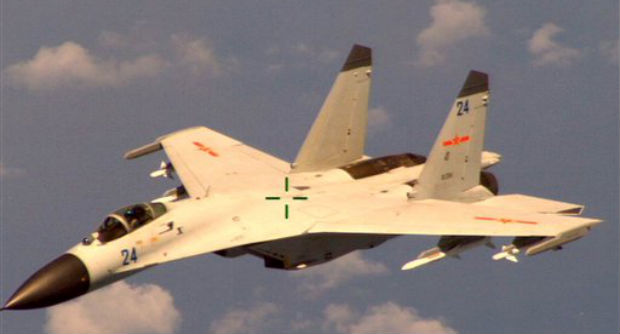
This handout photo provided by the Office of the Defense Secretary (OSD), taken Aug. 19, 2014, shows a Chinese fighter jet that the Obama administration said Friday conducted a “dangerous intercept” of a US Navy surveillance and reconnaissance aircraft off the coast of China in international airspace. AP/OSD
BEIJING — China’s Defense Ministry rejected US accusations that a Chinese fighter jet conducted a “dangerous intercept” of a US Navy surveillance aircraft off the southern Chinese coast.
Ministry spokesman Yang Yujun called the US accusations “groundless” in a statement issued Saturday night. He said the Chinese pilot conducted operations that were “professional and the Chinese jet kept a safe distance from the U.S. planes.”
Yang called the Chinese flights “routine identification and verification.”
Pentagon press secretary Rear Adm. John Kirby gave a different account Friday of the August 19 encounter about 135 miles (220 kilometers) east of China’s Hainan Island. He said the Chinese jet made several close passes by the Navy P-8 Poseidon plane, coming within 30 feet (9 meters) of it at one point.
Kirby said that included the Chinese jet doing a “barrel roll” maneuver over the top of the Poseidon — a modified Boeing 737 — and passing across the nose of the Navy plane apparently to show that it was armed. Kirby said the Chinese jet’s maneuvering posed a risk to the safety of the US air crew and was “inconsistent with customary international law.”
He said it was the fourth such incident since March of “close intercepts” involving Chinese jets.
The Chinese statement also said that a Navy P-3 Orion, an anti-submarine and surveillance aircraft, flew alongside the Poseidon. The Pentagon did not mention the second aircraft.
Tensions between the two countries have risen in the South China Sea, as China disputes territorial claims with U.S. ally the Philippines, Vietnam and other neighbors.
In 2001, a Chinese jet collided with a U.S. Navy surveillance aircraft off Hainan Island, killing the Chinese pilot and forcing the Navy plane to make an emergency landing on the island. Washington severed military relations with China after that episode.
In the latest encounter, Yang blamed “the large-scale and highly frequent close-in reconnaissance by the U.S. against China” as “the root cause of accidents endangering the sea and air military security between China and the United States.”
RELATED STORY